Trial field key to the species of PANAEOLUS in the Pacific Northwest
Prepared for the Pacific Northwest Key Council
By Gary Menser, Oregon Mycological Society
Copyright © 1980, 2003, 2009, 2019 Pacific Northwest Key Council
Photo copyright held by each photographer
Do not copy photos without permission
Reformatted with minor revisions by Ian Gibson 2003, 2009, 2019
INTRODUCTION
The genus Panaeolus of the family Coprinaceae contains the most common of the dung-inhabiting fungi. This genus is probably the first one to be encountered when searching in pastures and other grassy areas where horses and cows are kept or have been kept in recent years. Species in the genus are easy to find but often difficult to separate. Most are very similar and all have a cap margin that overlaps the gills.
With most species the spore print will be blackish, and the spores will retain their color in concentrated sulphuric acid. The gills do not deliquesce (melt away) as in the macroscopically close, black-spored genus Coprinus. Often gills are mottled as spores develop. Some species of Psathyrella closely resemble Panaeolus as do species of Stropharia.
None of the species should be considered as food although some species are consumed as a recreational drug. Some contain psilocybin and / or psilocin. It is also suspected that many contains psychoactive substances that as yet have not been identified. All species do contain the neurotransmitter serotonin.
The 2003 minor revision added Panaeolus alcidis, a discussion of synonymies in the P. papilionaceus group, a list of references and spore sizes, and a few remarks on similar species. The criteria to distinguish among P. acuminatus, P. foenisecii, and P. castaneifolius and among the P. papilionaceus group were changed. The 2019 minor revision changed ‘alcidis’ to ‘alcis’.
KEY TO SPECIES
1a Not on dung, margin not appendiculate
................................................................................11
1b On dung, margin appendiculate or not
................................................................................2
2a Membranous annulus present, viscid in wet weather, cap clay white, parabolic or campanulate (bell-shaped)
................................................................................Panaeolus semiovatus
| CAP 20-60 mm, tall conic to campanulate or parabolic, clay white, as it ages pallid buff, darker in the shade, smooth, often cracking on drying, margin even, paler, no veil remnants, soft and fragile, viscid in wet weather. GILLS pallid becoming mottled then darkening as fruit body ages, adnate, close to subdistant, edge white and minutely fringed, STEM 70-150 mm x 4-10 mm, straight and equal, hollow as it ages, whitish, smooth, membranous veil leaving a persistent annulus darkened by falling spores, in wet weather the annulus may wash off, apex striate to sulcate (grooved), base enlarged. HABIT and HABITAT solitary to gregarious, on dung and manure, especially of horses, spring and fall. DISTRIBUTION more common east of the Cascade Mountain Range. REMARKS similar to P. phalenarum which lacks the annulus. | Panaeolus semiovatus
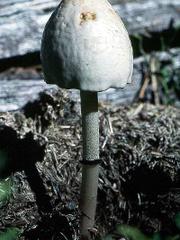
Paul Kroeger |
2b Stem without an annulus
................................................................................3
3a Staining blue when bruised
................................................................................Panaeolus cyanescens
| CAP 15-40 mm, campanulate or subhemispherical to convex as it ages, not hygrophanous, pallid to whitish, smooth, margin translucent-striate when wet, uneven at times, no veil remnants; fleshy. GILLS pallid to grayish black as they age, edges white; adnexed, close. STEM 70-110 mm x 1-3 mm, straight and equal, base enlarged; pallid to yellowish, grayish, or pinkish; smooth. HABIT and HABITAT solitary to widely scattered or in groups on or near dung in pastures, summer to fall. REMARKS rare in the Pacific Northwest. It is distinguished from blue-staining Psilocybe species by the combination of dry cap, black spores, and growth on dung. Occasionally the base of P. subbalteatus stains faintly bluish when bruised. | Panaeolus cyanescens
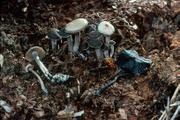
Michael Beug |
3b Not staining blue
................................................................................4
4a Cap over 5 cm
................................................................................Panaeolus phalenarum
| CAP 50-100 mm, hemispherical to convex, never umbonate, white when young to a pallid gray-white as it ages, smooth, cap may break up into dingy, rather large angular scales, the scales are larger near the disc, margin even to somewhat uneven. GILLS white at first, then mottled as they age, adnate, close, edge white with a cottony substance on the surface. STEM 80-200 mm x 5-15 mm, straight and equal and may be twisted-striate, solid and tough, polished white, smooth to striate or sulcate at apex, no veil remnants, base straight or curved. HABIT and HABITAT solitary to gregarious on dung heaps. REMARKS similar to P. semiovatus which has an annulus, but sometimes considered its synonym. | Panaeolus phalenarum
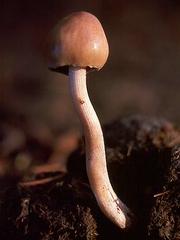
Paul Kroeger |
4b Cap less than 5 cm
................................................................................5
5a Cap 0.5-1.0cm wide, growing on deer or moose dung
................................................................................Panaeolus alcis
| CAP 0.5-1.0cm, bellshaped to conical, light gray, crown sometimes slightly brownish-ochre, very young also having olivaceous tone; no marginal remnants. GILLS dark gray, ascending, edge remaining paler grayish. STEM 50-90 mm x 0.5-1.5 mm, equal, pale ochre-gray, below brownish; pruinose. HABITAT deer and moose droppings. REMARKS found at least in BC (by Paul Kroeger); distinguished from P. papilionaceus sensu lato especially P. sphinctrinus var. minor by small size and lack of veil. | Panaeolus alcis
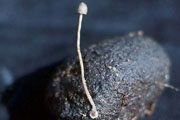
Paul Kroeger |
5b Cap over 1.0 cm or growing elsewhere
................................................................................6
6a Cap not campanulate, may be plane
................................................................................Panaeolus subbalteatus
| CAP 20-40 mm, convex or slightly umbonate, can be irregular, expanding to almost plane, hygrophanous, dull deep fawn color, marked near the margin with a dark narrow zone, pallid when dry, slightly wrinkled or smooth, margin incurved than expanding, not translucent-striate, fleshy. GILLS pallid to brownish, mottled then darkening, adnate or adnexed, close, edge white. STEM 20-80 mm x 2-6(10) mm, straight and equal, hollow, thick and cartilaginous, somewhat darker than cap, generally brown, smooth, marked with short white fibrils, no veil remnants, apex striate, base not enlarged, covered with white mycelium. HABIT and HABITAT solitary to gregarious or cespitose on freshly manured lawns, open ground, more common on horse dung than cow dung and has been found growing on cultivated mushrooms; primarily in spring, but common also in summer to fall. REMARKS P. acuminatus, P. foenisecii and P. fimicola are other species that may have a dark marginal band. P. acuminatus would key here if growing on dung. | Panaeolus subbalteatus
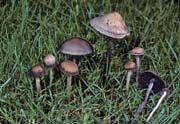
Kit Scates Barnhart |
6b Cap campanulate
................................................................................7
7a Growing solitary, margin not appendiculate
................................................................................Panaeolus fimicola
CAP 10-40 mm, campanulate to convex, brownish gray when moist, drying a yellowish gray, encircling brown ring near the margin, sometimes with a lighter ring within, darker when wet, smooth, margin scalloped. GILLS gray, becoming mottled and darkening as spores mature, adnate, close, edge white. STEM 40-50 mm x 2-4 mm, straight and equal, hollow, soft and fragile, dingy white, lighter near the top, brown as it ages, smooth, top half covered with a white powder, apex striate, base somewhat enlarged. HABIT and HABITAT solitary to scattered in soil or dung, sometimes found in well-fertilized lawns and/or grassy places in woods, late spring to mid-fall. REMARKS P. acuminatus, P. foenisecii and P. subbalteatus are other species that may have a dark marginal band. P. acuminatus would key here if solitary on dung.
7b Margin appendiculate
................................................................................P. papilionaceus sensu lato....8
8a Cap with raised reticulations
................................................................................Panaeolus retirugis
| CAP 10-30 mm, globose, conic or campanulate, dark smoky becoming gray brown as it ages, darker when moist, shiny when dry, surface with raised ribs or wrinkles, margin incurved when young, appressed to the stem, fragments from the ringlike veil may be attached, appendiculate. GILLS pallid then becoming mottled and darkening as they age, adnate or adnexed, close, edge white and downy. STEM 40-60 mm x 2-4 mm, straight and equal, hollow, stiff and fragile, whitish becoming purplish as it ages, darker near base, polished and finely powdered, no veil remnants, apex striate, base darker, may be slightly enlarged. HABIT and HABITAT solitary to gregarious, often in large quantities in cow pastures, spring to fall. REMARKS see discussion under P. papilionaceus sensu stricto below. | Panaeolus retirugis
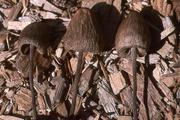
Paul Kroeger |
8b Cap not reticulate
................................................................................9
9a Cap whitish even when moist
................................................................................Panaeolus papilionaceus sensu stricto
CAP 20-30 mm, subhemispherical, then becoming bell-shaped as it ages, pale gray, as it ages tinged pink, at most tinged ochraceous at disc, darker near the disc and shining when dry, smooth or cracked, fragments from the ringlike veil may be attached, appendiculate, thin and brittle. GILLS grayish at first, becoming mottled dark grayish black, adnate, close, edges white. STEM 40-50 mm x 3-6 mm, straight and equal, hollow, whitish, darkening brown from the bottom up as it ages, surface smooth, shiny, covered with a white powder, base somewhat enlarged. HABIT and HABITAT scattered to gregarious on dung in fall or spring, not generally attached directly to the dung. REMARKS This description is for P. papilionaceus in its narrow sense, but Stamets accepts the view of Gerhard (1996) which includes also P. sphinctrinus (Fr.) Quél., P. campanulatus (Fr.) Quél., and P. retirugis (Fr.) Quél. as synonyms of this taxon. Spore sizes for the four species from Watling (see end of key) are different in other sources. Common as a group.
9b Cap light brown to olive gray
................................................................................10
10a Cap olive-gray
................................................................................Panaeolus sphinctrinus
CAP 10-30 mm, obtuse then broadly campanulate, never expanding to plane, hygrophanous, dark gray-brown or dark olive-gray or olive-black or lead gray or smoky gray, drying pallid buff, smooth, shiny when dry, margin appressed to the stem and incurved, appendiculate. GILLS pallid becoming mottled then darkening as they age, adnate, crowded, edges white. STEM 25-75 mm x 2-4 mm, straight and equal, hollow and fragile, whitish to dark smoky gray, lighter near the top, darkening from the bottom as it ages, smooth, polished and covered with a fine white powder, apex substriate, base slightly enlarged and covered with white mycelium. HABITAT manured meadows, dung. REMARKS see discussion under P. papilionaceus sensu stricto above.
10b Cap reddish gray-brown
................................................................................Panaeolus campanulatus
| CAP 10-40 mm, obtuse, parabolic to campanulate or hemispherical, never expanded, hygrophanous, reddish gray-brown drying yellow-gray-brown, smooth, may crack as it ages, incurved when young, then expanding, veil is white toothed fringe (appendiculate); GILLS gray becoming mottled as spores mature, then darkening as they age, adnate, close, edge white. STEM 30-120 mm x 1-3 mm, straight and equal, hollow and fragile, reddish brown, the top often dotted with spores, polished and covered with a fine white powder, apex substriate, covered with white mycelium, base slightly enlarged. HABIT and HABITAT solitary or in groups on or near dung in pastures and meadows. REMARKS see discussion under P. papilionaceus sensu stricto above. | Panaeolus campanulatus group
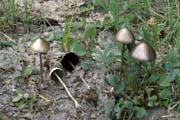
Steve Trudell |
11a (1a) Spore print dark brown
................................................................................Panaeolus foenisecii
| CAP 10-40 mm, conical to convex, some will become broadly umbonate to plane, like a sombrero, hygrophanous, reddish-brown drying to dingy buff and shining, smooth, may be cracked as it ages or in drying, margin may have dark band, and is striate when moist, no veil remnants; fleshy. GILLS pallid to dull brown or dark brown, mottled by maturing spores, then darkening as it ages, adnate, close to subdistant, edge white. STEM 40-80 mm x 2-4 mm, straight and equal or may be flattened or twisted-striate; hollow and rigid; white to dingy brownish (often becoming brown from the base upward); covered with soft and short white hairs, no veil remnants, apex striate; base enlarged, covered with white mycelium. HABIT and HABITAT solitary to gregarious, grows on lawns and pasture land, late spring to fall, main fruiting in summer. REMARKS Common. The correct name is considered to be Panaeolina foenisecii by some authors. P. foenisecii has deep brown or purple brown spore deposit, unlike other Panaeolus species which have black or blackish spore deposit. P. acuminatus, P. fimicola and P. subbalteatus are other species that may have a dark marginal band. | Panaeolus foenisecii
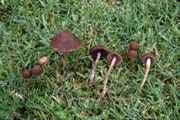
Steve Trudell |
11b Spore print dark purplish gray-black
................................................................................12
12a Cap chestnut to deep reddish brown, drying lighter, common
................................................................................Panaeolus acuminatus
| CAP 15-30 mm, conical to conical-bellshaped, then expanding, wider than high with age, hygrophanous, dark reddish brown drying to tan brown and shiny, margin smooth and may have dark band, scalloped when young and translucent-striate when moist; fleshy. GILLS pallid, blackening as they age, adnexed, crowded, edge white. STEM 25-75 mm x 2-4 mm, straight and equal, hollow and brittle, pallid above, brown downwards, all brown with age, smooth, covered with a white powder, apex striate, base enlarged and covered with white mycelium. HABIT and HABITAT solitary to gregarious, on well-manured soil, grassy areas, at the forest edge, or on dung, fruiting all year except late winter. REMARKS common in the Pacific Northwest. P. foenisecii, P. fimicola and P. subbalteatus are other species that may have a dark marginal band. P. subbalteatus may key out here if not on dung, with its black spore print, and conspicuous marginal band on the cinnamon brown to orange cinnamon brown cap. | Panaeolus acuminatus
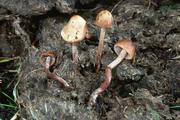
Michael Beug |
12b Cap color dark smoky gray-brown, drying lighter, rare
................................................................................Panaeolus castaneifolius
| CAP 10-40 mm, convex, never fully expanding, hygrophanous, dark smoky gray when moist, soon drying to straw yellow or pale ochraceous, and staying more reddish brownish at apex and more smoky brownish along margin, smooth, often wrinkled, margin even and incurved when young, no veil remnants, translucent-striate when moist; thick and firm. GILLS pallid darkening to chestnut as they age, adnate to adnexed, subclose, edge white. STEM 45-70 mm x 4-6 mm, straight and slightly tapering toward the base, hollow, cartilaginous, thick and firm, same color as cap but may be lighter near the top when young, finely powdered, no veil remnants, apex striate, base not enlarged. HABIT and HABITAT gregarious in grassy places, summer to fall. REMARKS Rare in Northwest. The correct name is considered to be Panaeolina castaneifolia by some authors. | Panaeolus castaneifolius
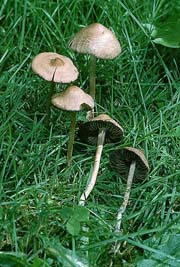
Michael Beug |
GLOSSARY
appendiculate - margin of cap fringed with hanging fragments of the veil
sensu lato - in a wide sense
sensu stricto - in a narrow sense
hygrophanous - cap surface changing color markedly as it dries, usually having a water-soaked appearance when wet and turning a lighter opaque color on drying
subclose - between close and crowded
subhemispherical - somewhat hemispherical, nearly hemispherical
REFERENCES
References were not given in the original key; however, all of the major field guides include at least some of these species. In addition the following are useful.
- Ammirati, J.F., J.A. Traquair, and P.A.Horgen. 1985. Poisonous mushrooms of Canada including other inedible fungi. Fitzhenry and Whiteside, Markham Ont. 396p. [for P. subbalteatus]
- Breitenbach, J., Kränzlin, F. 1995. Fungi of Switzerland Volume 4 Agarics Second Part. Edition Mykologia Lucerne.
- Hansen, Lise, Henning Knudsen editors. 1992. Nordic Macromycetes. Volume 2. Nordsvamp, Copenhagen.
- Moser, M. 1983. Keys to Agarics and Boleti. Translated by S. Plant. Publisher Roger Phillips, London.
- Smith, Alexander H 1972. The North American Species of Psathyrella. Memoirs of The New York Botanical Garden Volume 24. [for P. castaneifolius as Psathyrella castaneifolius, P. foenisecii as Psathyrella foenisecii]
- Stamets, Paul. 1996. Psilocybin Mushrooms of the World. Ten Speed Press, Berkeley. [included Panaeolus]
- Stuntz, D.E., B.F. Isaacs. 1962. "Northwestern Fungi I." Mycologia 54: 272-297. [for P. semiovatus]
- Watling, R., Norma M. Gregory. 1987. British Fungus Flora Agarics and Boleti 5 Strophariaceae and Coprinaceae p.p. Royal Botanic Garden, Edinburgh.
SPORE SIZES
| Panaeolus acuminatus (Secr.) Quél. sensu Ricken |
11-16 x 7.5-11 um |
| Panaeolus alcis M.M.Moser |
16-18 (19) x 7-9 um |
| Panaeolus campanulatus (Fr.) Quél. |
12-14 x 7-10 um |
| Panaeolus castaneifolius (Murrill) Quél. |
12-15 x 7-9.5 um |
| Panaeolus cyanescens Berk. & Broome. |
12-14 x 7.5-11 um |
| Panaeolus fimicola Fr. |
11-14 x 7-9.5 um |
| Panaeolus foenisecii (Fr.) Quél. |
12-17 x 6-9 um |
| Panaeolus papilionaceus (Bull.ex Fr.) Quél. sensu stricto |
14-18 x 8-11 um |
| Panaeolus phalenarum (Fr.) Quél. |
14-22 x 9-14 um |
| Panaeolus retirugis (Fr.) Quél. |
12-14 x 7-9 um |
| Panaeolus semiovatus (With.: Fr.) Wunsche |
15-22 x 8-12 um |
| Panaeolus sphinctrinus (Fr.) Quél. |
14-18 x 9-11.5 um |
| Panaeolus subbalteatus Berk. & Broome |
11.5-14 x 7.5-9.5 um |
INDEX
| GENUS AND SPECIES |
KEY ENTRIES |
| |
|
| PANAEOLUS (Fr.) Quél. |
|
| P. acuminatus (Secr.) Quél. sensu Ricken |
12a |
| = Panaeolus rickenii Hora |
|
| P. alcis M.M.Moser |
5a |
| P. campanulatus (Fr.) Quél. |
10b |
| P. castaneifolius (Murrill) A.H. Sm. |
12b |
| = Panaeolina castaneifolia (Murrill) Bon |
|
| = Psathyrella castaneifolia (Murrill) A.H. Sm. |
|
| P. cyanescens Berk. & Broome |
3a |
| = Copelandia cyanescens (Berk. & Broome) Sacc. |
|
| P. fimicola Fr. |
7a |
| P. foenisecii (Pers.) Schröt. |
11a |
| = Panaeolina foenisecii (Pers.) Maire |
|
| = Psathyrella foenisecii (Pers.) A.H. Sm. |
|
| P. papilionaceus (Bull.ex Fr.) Quél. |
9a |
| P. phalenarum (Fr.) Quél. |
4a |
| = Anellaria phalenarum |
|
| P. retirugis Fr. |
8a |
| P. semiovatus (With.: Fr.) Wunsche |
2a |
| = Anellaria semiovata (With.:Fr.) Pearson & Dennis |
|
| P. sphinctrinus (Fr.) Quél. |
10a |
| P. subbalteatus Berk. & Broome |
6a |
- END -

